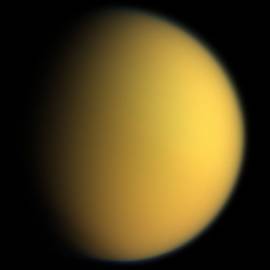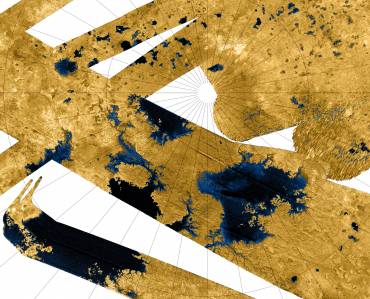The Stanford School of Earth, Energy & Environmental Sciences is now part of the Stanford Doerr School of Sustainability.
This page is currently being maintained for archival purposes only. For the latest information, please visit us here.
Sensory Earth - Earth from 750 million miles away
Planetary geophysicist Howard Zebker analyzes radar images beamed back from Saturn's largest moon and finds a planetary body that's both alien and yet somehow familiar.
By
Miles Traer
<p>Stanford School Of Earth Sciences</p>
November 10, 2014

Perspective, false color image of Ligeia Mare, Titan's second largest sea, with vertical exaggeration. Elevation data provided by Cassini satellite (courtesy of Howard Zebker and Randy Kirk, Cassini Radar team).
The river of liquid methane flowed downhill, carving a long serpentine scar across the frozen surface before draining into the massive lake, called Kraken Mare. Kraken Mare. Yeah, those NASA scientists knew how to name cool stuff like that. Earthlings could measure the lake’s size, roughly three times bigger than the greatest of the great lakes, Lake Superior. The nitrogen-rich air sat motionless upon Kraken Mare’s mirror-like surface. The liquid methane plunged deeper into the abyss of nearly frozen hydrocarbons where it would wait until currents brought it back to the surface. There, it evaporated into Titan’s atmosphere until it rained down on the poles, one Saturnian year later (around 30 Earth years).
That’s not science fiction. That’s what’s likely happening on Saturn’s largest moon, Titan, right now. As you read this. That’s happening. 750 million miles (1.2 billion kilometers) away.
A loooooong time ago… all the way back in 1997… hollywood made a film called Gattaca about a potential manned journey to Titan, wherein a young Ethan Hawke claimed, “It’s got a cloud around it so thick nobody can tell what’s underneath.”
While Ethan Hawke and his well-established scientific credentials were correct at the time, today he’s dead wrong. Just ten years later, we actually know what Titan’s surface looks like thanks to the Cassini-Huygens satellite mission (co-run by NASA, the European Space Agency, and the Italian Space Agency) and contributions from the Radar Science Team. Planetary geoscientists like Howard Zebker, a geophysics professor at Stanford and a member of the radar team, use sensitive radar instruments to penetrate Hawke’s supposedly impenetrable cloud.

Titan, natural color image. Admittedly, we can't see the surface. That's one point to you, Mr. Hawke (courtesy of NASA).

Photograph taken from Titan's surface by the Huygens landing probe. Haha, Ethan Hawke! We know what it looks like! The rounded blocks, like rounded rocks found on Earth, further suggest the flow of liquids across Titan's surface (courtesy of NASA).
Sometimes, to better understand our planet, we have to change our perspective and look at places like Titan. Why Titan? Because despite its science fiction-sounding reality, it shares remarkable similarities with Earth.
According to Zebker, “Titan is, in many ways, the best analog that we have in the solar system to a body like the Earth because it is the only other body that we know of that has a complex cycle of solid, liquid, and gas constituents." It’s a place that’s alien, but visually somehow familiar.
Flowing liquids on the surface? Check. Titan has rivers of liquid methane and ethane that flow into gigantic lakes that sit at 300 degrees Fahrenheit below zero. It is the only planetary body in our solar system other than Earth to have stable flowing liquids.
Atmosphere? Check. Titan is the only moon in our solar system with a thick atmosphere, and other than Earth, the only one composed mostly of nitrogen. Titan’s atmosphere is approximately 1.5 times denser than Earth’s and it sits like a heavy, ochre fog over the surface. It’s thick enough that scientists have to use radar to penetrate the clouds.
Seasons? Check. Much like Earth, the nitrogen atmosphere and liquid hydrocarbon lakes and rivers shift with exposure to solar radiation despite the fact that Titan receives just one-percent of the sunlight Earth does. The seasons last for several Earth years, and some scientists speculate that seasonal climate circulations bring methane rain to the northern hemisphere which refill the moon’s hydrocarbon seas during the northern winter.

False color image of Titan's surface. Yellow/orange areas indicate solid surfaces; blue areas indicate liquid surfaces. About half of the gigantic sea, Kraken Mare, can be seen at the lower left. Ligeia Mare, Titan's second largest methane/ethane sea, sits to the right of Kraken Mare (courtesy of NASA).
We know all of this because the Cassini spacecraft can look at Titan with electromagnetic waves outside our visible spectrum, specifically by using microwaves. By bouncing waves off of Titan’s surface and measuring the strength of the returning signal, scientists can determine how rough the surface is - a stronger return signal when looking directly beneath the spacecraft indicates less scatter and a smoother mirror-like surface. By measuring the radiometric brightness temperature - basically a measure of emitted energy - scientists can use basic physics principles to deduce the surface’s composition.
In a recent paper published in the journal Geophysical Research Letters, Zebker and his co-authors used these methods and radar data to examine Ligeia Mare, Titan’s second largest sea. They found that the sea is likely composed of liquid methane, and that the surface was remarkably smooth, a finding that challenges existing models that predicted strong nitrogen winds blowing across Titan’s surface and generating generating waves.
“The surface of the lake didn’t vary by more than a few millimeters,” Zebker told me. “This is far smoother than almost any natural surface on Earth.”
The recorded radiometric brightness temperature further constrained Titan’s surface composition, suggesting that the land masses and lakes are a mix of solid and liquid hydrocarbons sitting like Earth’s crust atop a largely water ice interior, corroborating results and interpretations pieced together from previous observations.
Other instruments on the Cassini satellite have found trace amounts of ammonia in Titan’s atmosphere, likely originating from icy “cryovolcanoes” that are erupting on Titan’s surface (I’m seriously not making any of this up. Titan is amazing.) Ammonia, methane and nitrogen closely resemble Earth’s early atmosphere. As planetary bodies go, Titan is an exciting example of proto-Earth conditions.
Titan continues to be a planetary-scale laboratory for scientists like Zebker. As Zebker points out, the physics on Titan is the same as on Earth, but the chemistry is very different because Titan’s surface is mostly hydrocarbons rather than rock and water. But it isn’t just Titan’s strange chemical makeup that gives us a unique perspective of our own planet.
On July 19, 2013 the wide-angle camera on the Cassini spacecraft took a photo of Saturn silhouetted against the sun and surrounded by the vast blackness of space. Nestled below the faint glow reflecting from Saturn’s rings was a speck of pale blue light, what Carl Sagan referred to as “a mote of dust.”

The new "pale blue dot" (courtesy of CICLOPS/NASA/JPL/SSI).
That pale blue dot is Earth. Our Earth as seen from nearly 900 million miles away. This isn’t microwave radar imaging, or radiometric brightness temperature, or chemical analysis. This is a portrait of us as we existed the moment the camera shutter snapped, and a reminder that when we want to be, we’re pretty amazing at the science of exploration.
Howard Zebker is a professor of Geophysics and Electrical Engineering at Stanford University.





